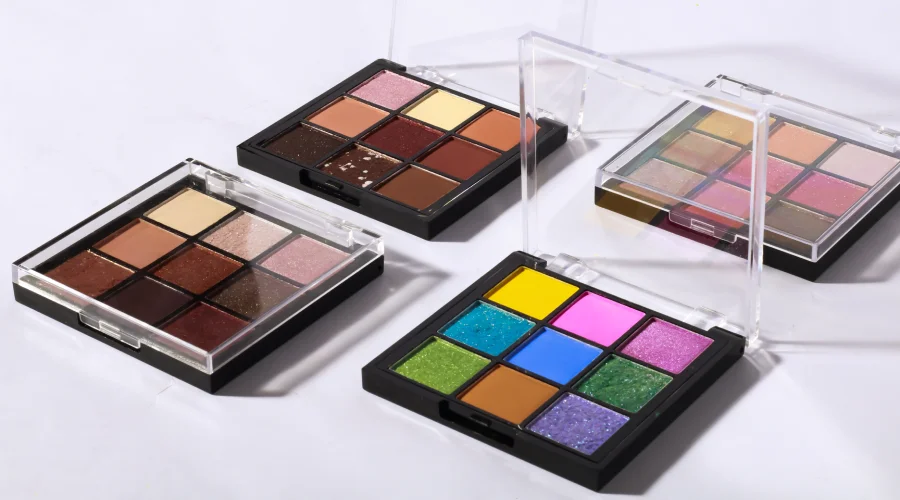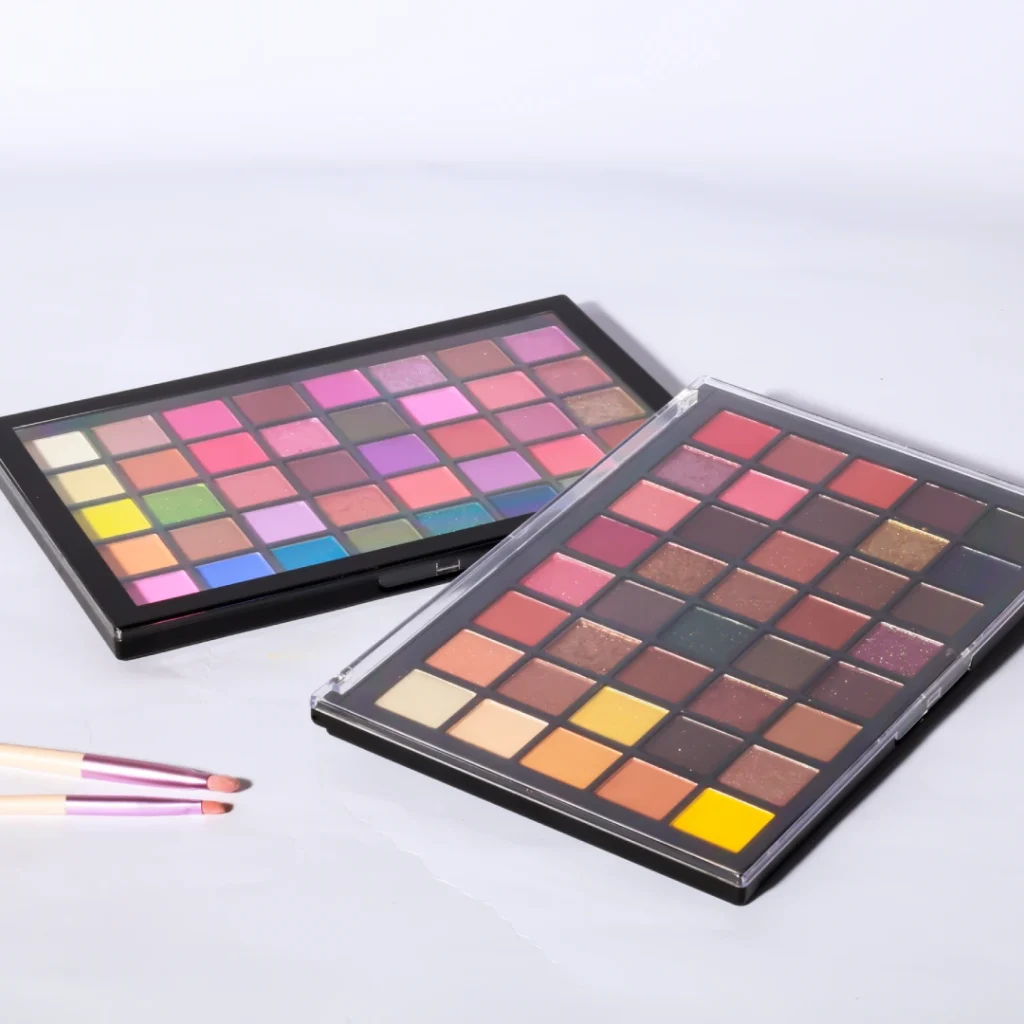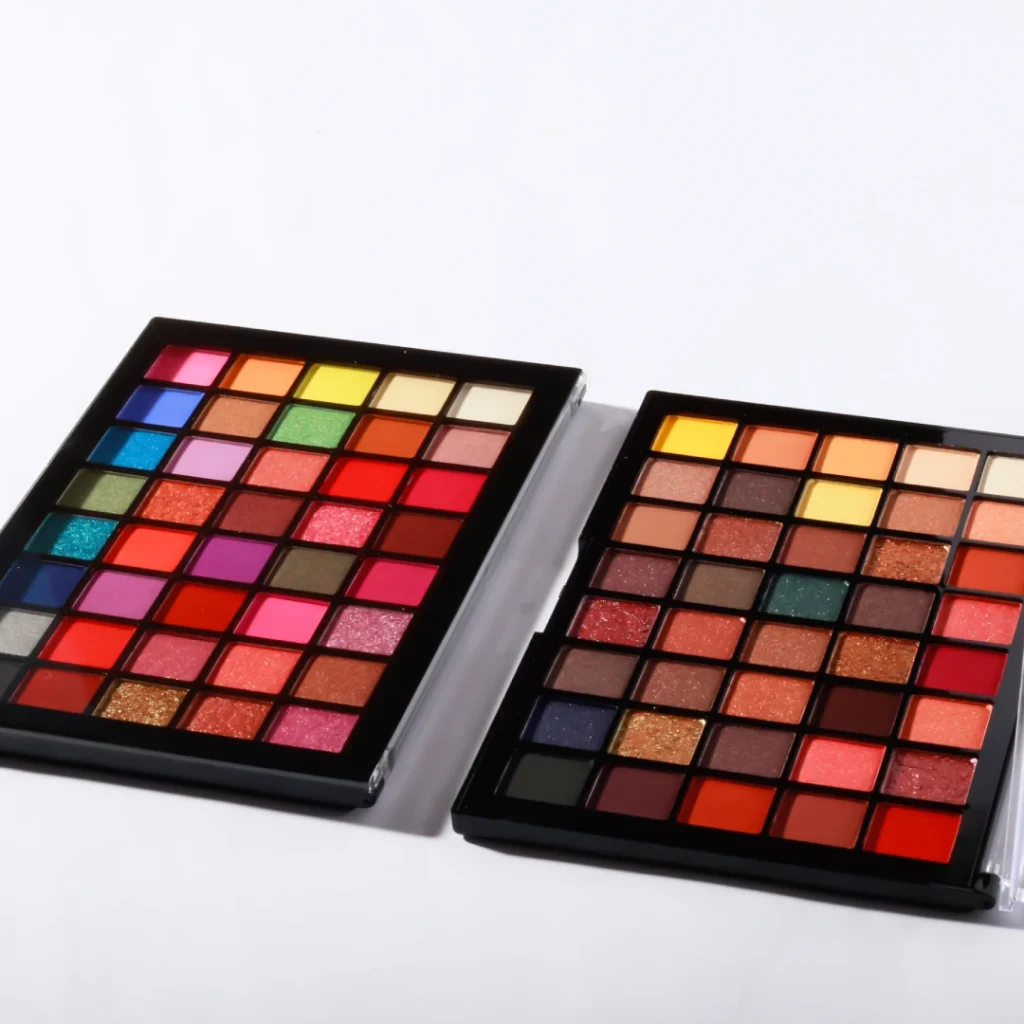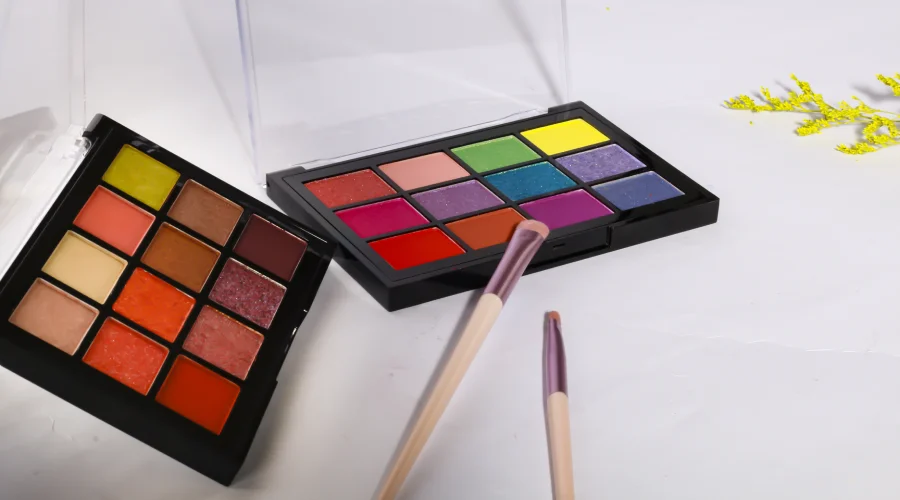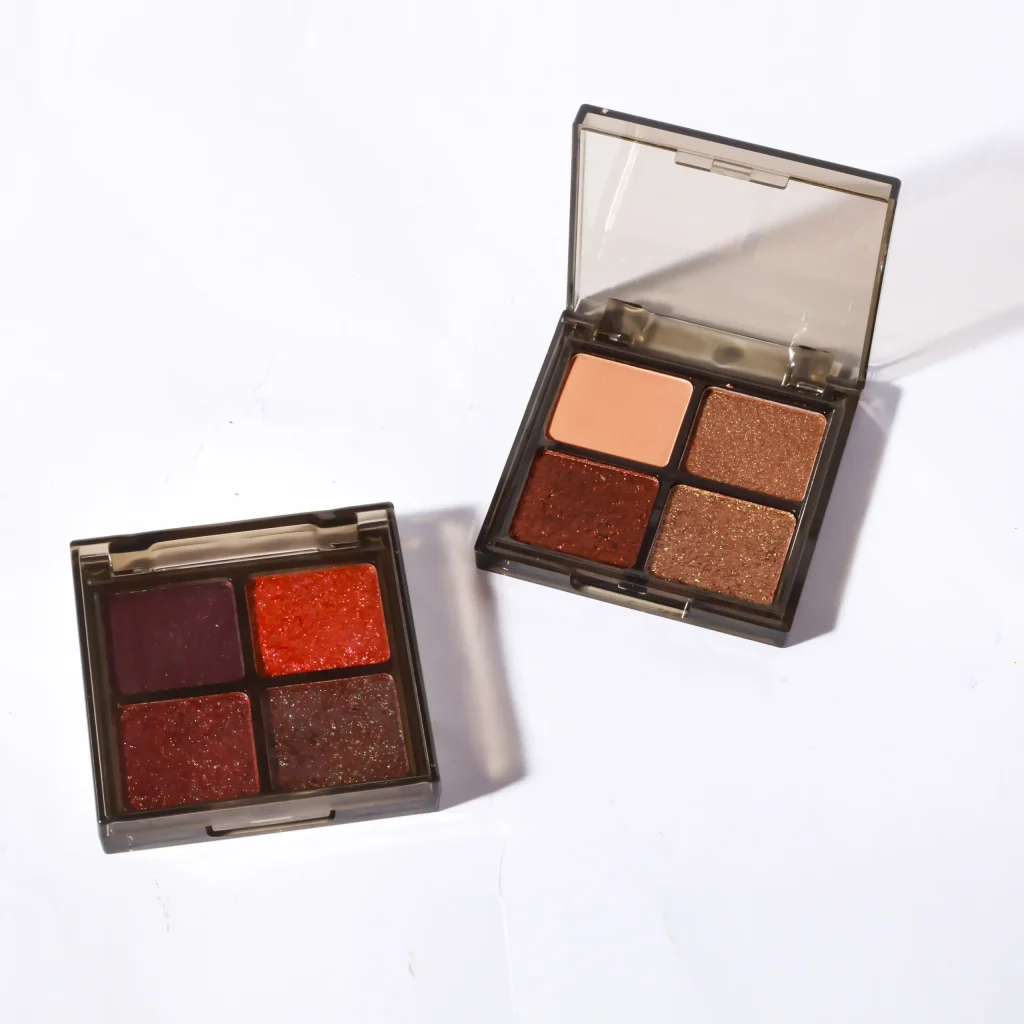Eyeshadow is more than color—it’s a way to shape light, shadow, and emotion on the face. Whether brushed on softly or pressed with fingertips, each technique tells a story of texture and control.
The Purpose of Eyeshadow in Makeup Artistry
Eyeshadow is designed to enhance the natural contour of the eyes. By adjusting contrast, color depth, and reflection, it can make the eyes appear larger, brighter, or more defined. Artists often treat the eyelid as a canvas, where shadow and highlight mimic natural light behavior.
In professional makeup training, eyeshadow is also used to study color theory. A warm bronze near the crease or a cool taupe under the brow bone helps balance undertones. Each pigment interacts with light differently, which is why texture choice—matte, shimmer, or satin—matters as much as shade selection.
How Application Tools Influence Color and Finish
The choice between brush and fingers is not just about comfort. Each tool changes how eyeshadow behaves on the skin. Brushes lift and diffuse powder gently, allowing thin, even layers. Fingers, on the other hand, press pigment directly, creating denser color and a more reflective finish.
For example, a fluffy blending brush scatters particles loosely, resulting in soft edges and gradual transitions between shades. This technique is ideal for creating dimension. In contrast, finger application slightly warms the product, especially cream and shimmer shadows, helping them melt into the skin.
According to studies on tactile application in cosmetic science (Journal of Cosmetic Dermatology, 2020), the warmth of skin can alter pigment spread and binder flexibility. That’s why some shades appear richer when applied by hand. Still, using fingers can reduce precision—especially in detailed crease or liner work.
The Science Behind Brush vs. Finger Application
Every makeup look is a small experiment in physics and chemistry. When eyeshadow meets skin, countless micro-interactions occur—between pigment particles, oils, pressure, and temperature.
Texture, Pressure, and Pigment Distribution
Brushes and fingers distribute eyeshadow in distinct physical ways. A brush’s fibers act like tiny springs, picking up dry pigment and scattering it evenly. The motion spreads pressure across the bristles, giving a light, airy finish. This technique helps with blending transitions, especially for matte eyeshadows.
Fingers, however, create direct contact. The pressure is more concentrated, pushing pigment deeper into the skin’s micro-texture. This can make shimmer or metallic eyeshadow appear brighter, as light reflects more strongly from the compacted surface. Yet, the result depends on control—too much pressure may cause patchiness.
In makeup science, this difference is described as mechanical dispersion. A study published in the International Journal of Cosmetic Science (2019) showed that varied application forces influence pigment bonding on the skin. The denser the contact, the more reflective and opaque the finish appears.
In practical terms, imagine applying a soft pastel with a large blending brush—it feels like painting mist. Then try the same with your fingertip—it feels like sculpting. Each motion changes how light interacts with the pigment, shifting not only the visual effect but also the emotional tone of the look.
How Skin Temperature Affects Cream and Powder Shadows
The human fingertip is naturally warm—around 93°F (34°C). This warmth softens certain eyeshadow binders, especially in cream or hybrid formulas. As a result, the pigment spreads smoothly, melting into the skin with a dewy or satin texture. Brushes, being cooler, do not trigger this same softening effect.
Powder eyeshadows behave differently. Since they lack strong emollients, warmth doesn’t alter their texture much. Instead, brushes perform better here, as their fibers can trap and release fine particles gradually. This allows better layering and prevents harsh lines between shades.
Makeup chemists often note this interaction between heat and binder viscosity. When warmed slightly, silicone-based creams become more flexible, allowing better adhesion to skin surfaces (Cosmetic Formulation Review, 2021). That’s why finger-applied shimmer shades often seem to “pop” more vividly.
In the end, neither tool is scientifically superior—they simply produce different reactions. The brush operates like a precision instrument, while the finger works as a natural applicator that merges warmth and pressure. Both depend on understanding texture, touch, and the subtle physics of pigment behavior.
Using Makeup Brushes for Eyeshadow — Pros and Limitations
Makeup brushes have long been the professional’s choice for applying eyeshadow. They offer control, hygiene, and the ability to sculpt color with precision. Yet, like all tools, brushes come with trade-offs.
>> Is Liquid Eyeshadow Better Than Powder?
Precision and Blending Control
A good eyeshadow brush is designed to mimic the movements of a painter’s tool. Each stroke distributes pigment in a controlled way, allowing gradual build-up of color. The bristles’ shape and density affect how much product is lifted and how softly it lands on the skin.
For example, a dense flat brush deposits pigment with focus, perfect for packing shimmer on the eyelid. A fluffy blending brush, by contrast, diffuses powder outward, softening hard edges. This control lets artists create dimension—from subtle transitions to complex gradients that frame the eyes.
In professional settings, blending is treated as both art and science. Too much motion removes pigment; too little leaves harsh lines. According to makeup educators at the Make-Up Designory Institute (2022), mastering brush pressure and angle determines how natural or dramatic a look appears.
Best Brush Types for Different Eyeshadow Formulas
Not all brushes perform the same. Powder eyeshadows, for instance, benefit from soft, natural-fiber brushes that hold loose pigment well. Synthetic bristles, however, are better for cream or liquid shadows since they resist product absorption and provide smoother application.
For fine detail, smaller tapered brushes work best, especially for crease definition or outer corner shading. Meanwhile, wide flat brushes are ideal for base application, covering more surface area with fewer strokes. Many artists combine multiple brushes to balance coverage and control.
In recent years, brush technology has evolved. Some fibers are engineered to mimic animal hair texture while remaining vegan and more consistent in pigment release. This reflects how material science continues to influence even the smallest tools in makeup artistry.
Common Mistakes When Using Brushes
One common issue is overloading the brush with eyeshadow. This causes fallout—tiny particles that drop onto the cheeks. Tapping off excess pigment before application prevents uneven texture and maintains cleaner lines.
Another mistake involves skipping brush cleaning. Residue buildup can alter color payoff and blend quality. Over time, leftover oils from skin contact can harden bristles or harbor bacteria. Dermatologists, including those cited in the Journal of Cosmetic Dermatology (2020), recommend washing brushes weekly with mild cleanser to maintain hygiene.
Finally, some users rely on one brush for all purposes. This limits the range of effects achievable with eyeshadow. Professional artists often switch brushes mid-look, treating each as a unique tool for shading, blending, or highlighting. Learning when to switch ensures consistency and precision throughout the makeup process.
Applying Eyeshadow with Fingers — The Hands-On Method
Using fingers to apply eyeshadow may seem simple, yet it involves a subtle understanding of touch and texture. This method connects you directly to the product, allowing a tactile sense of control that brushes can’t always match. For many, finger application feels intuitive—almost like sculpting with color.
The Natural Warmth Advantage
The human fingertip is naturally warm, and that warmth changes how eyeshadow behaves. When you press a cream or shimmer formula with your finger, the mild heat softens the binders and oils in the product. This allows smoother blending and a slightly glossy, skin-like finish that brushes sometimes struggle to create.
Makeup chemists describe this as thermal activation—the gentle warming of waxes and emollients that improves spreadability. The Journal of Cosmetic Science (2021) notes that heat can reduce product stiffness, letting pigments glide more evenly. It’s why finger-applied metallic shadows often appear brighter and more reflective.
Finger pressure also helps in depositing concentrated pigment where needed. Unlike brushes, which diffuse color, fingertips press pigment directly onto the skin’s surface. This method works especially well for quick one-shade looks, where intensity and simplicity matter more than fine detailing.
Finger Application Techniques for a Smooth Finish
Good technique is key when applying eyeshadow by hand. Light tapping or patting motions work best for shimmer and metallic shades. This prevents streaking and keeps pigment in place. For cream shadows, using the ring finger—naturally gentler than the index finger—helps create softer transitions across the lid.
Professional artists often use the fingertip to blend edges after brush application. The warmth helps merge layers together, giving a seamless, natural fade. Some even combine both tools: a brush for defining the crease and fingers for applying the lid color. This hybrid approach brings the best of both worlds—precision and warmth.
Another tip involves using clean, dry fingers. Oils or moisture can change product texture, especially in powder eyeshadows. A simple wipe before application ensures that pigment adheres evenly without clumping or smudging.
When Fingers Fall Short
Despite their versatility, fingers have limits. The biggest challenge is precision. They can’t reach tight corners or create fine lines around the crease and lash line. For detailed work, a small brush remains essential.
Hygiene is another concern. Direct contact with the skin increases the risk of transferring bacteria, especially around the sensitive eye area. Experts from the American Academy of Dermatology (2020) warn that unwashed hands can introduce irritants or cause breakouts in acne-prone users.
Finally, not all formulas respond well to finger application. Matte and loose powder eyeshadows often apply unevenly, as fingers can’t grip fine particles like bristles do. In these cases, brushes offer better blending control and cleaner color transitions.
Comparing Results — Brush vs. Finger Application
When it comes to eyeshadow, both brushes and fingers can achieve beautiful looks—but the results aren’t identical. Each tool influences color strength, texture, and wear in unique ways.
Pigment Payoff and Color Intensity
The first noticeable difference between brushes and fingers lies in pigment payoff. Brushes pick up eyeshadow evenly and allow thin, gradual layering. This gives more control over intensity, which is useful for subtle, professional finishes.
Fingers, however, tend to deliver bolder color. The natural oils on the skin help press pigment directly into the lid, especially for metallic or shimmer shades. This close contact creates a denser and more reflective surface, making colors look richer under light.
Blendability and Layering Effects
Blending is where brushes often excel. The soft bristles distribute powder smoothly, creating seamless transitions between shades. This technique is especially important for multi-color looks or gradient eyeshadow designs. Brushes allow light, circular motions that diffuse harsh lines without removing too much pigment.
Finger blending feels different. The warmth of the fingertip can melt cream or shimmer shadows together beautifully but may cause uneven transitions with matte formulas. Since fingers apply more pressure, they sometimes move product around instead of merging it softly.
Professional makeup trainers often teach a hybrid method—start layering with a brush, then finish with a fingertip to smooth the surface. This combination creates depth and luminosity, balancing precision with softness. The tactile warmth of the finger brings life to the texture, while the brush maintains structure.
>> What should we apply before eyeshadow?
Longevity and Crease Resistance
Durability also changes depending on the tool used. Brushes typically apply thinner, more even layers of eyeshadow, which helps pigments bond to primed skin. This leads to better longevity and less creasing throughout the day. Powder formulas, when applied with brushes, are less likely to clump or settle into fine lines.
Finger application, while offering strong adhesion, can sometimes deposit too much product. Thick layers—especially on oily lids—are more prone to creasing. The heat from fingers can also soften wax binders in some formulas, reducing their long-term stability.
According to cosmetic wear tests published by the Society of Cosmetic Chemists (2021), eyeshadow longevity depends heavily on film thickness and binder activation. The more even the application, the longer it lasts.
Still, finger-applied shimmer shades often retain their reflective quality longer, as the compacted pigment resists fading. In practice, both tools perform well when used correctly—it’s less about which is better, and more about how the product is handled.
Matching the Tool to the Eyeshadow Formula
Not all eyeshadows behave the same. The choice between brush and fingers often depends on the product’s base—powder, cream, or glitter. Each formula reacts differently to touch, temperature, and motion, making tool selection a small but crucial part of achieving the desired look.
Powder Eyeshadows
Powder eyeshadows are the most traditional and widely used type. They are made from finely milled pigments mixed with binders like talc or mica. Brushes are ideal for these formulas because they pick up loose particles efficiently and distribute them in thin, even layers.
A fluffy blending brush, for example, helps diffuse matte shadows without creating harsh lines. Using circular motions, it allows a gradual color build-up that mimics natural shading. Pressing too hard, however, can cause fallout—tiny pigment dust settling under the eyes.
Finger application works for powder shadows only in limited ways. While a fingertip can pack color onto the lid, especially in shimmer or satin textures, it often struggles with blending. The natural oils of the skin may also disrupt powder adhesion, creating patchy spots. In short, brushes are the more reliable choice for powders.
Cream and Liquid Eyeshadows
Cream and liquid eyeshadows behave differently—they contain emollients and silicones that respond to warmth. This makes fingers a surprisingly effective tool. The gentle heat from the skin softens the product, allowing it to glide smoothly and blend seamlessly over the eyelid.
When using fingers, tapping motions work best. The pressure helps spread the pigment evenly without streaking. It’s a technique favored by many professional artists for creating quick, glossy finishes. Creams also adhere better when gently pressed rather than brushed, reducing patchiness.
However, brushes still have their role. A synthetic flat brush can shape cream eyeshadow precisely along the crease or lash line, where fingers lack control. Brushes also help when layering multiple shades, as they prevent colors from mixing too much. The key is balance—fingers for base blending, brushes for detail.
Glitter and Metallic Finishes
Glitter and metallic eyeshadows demand special handling. These formulas rely on dense pigment and reflective particles that need firm pressure to stick. Here, fingers often outperform brushes. The direct contact helps press the glitter onto the skin, ensuring maximum shine and minimal fallout.
Makeup chemists point out that skin oils act as a natural adhesive, helping glitter pigments bind more securely. This is why fingertip application often results in a more vibrant, mirror-like effect. A brush, especially one that’s too soft, may simply move the glitter around instead of anchoring it.
For added precision, some artists use a combination: fingers for initial placement and a firm, flat brush for refining edges. When working with loose glitter, a damp brush can also help lock particles in place.
Ultimately, matching the tool to the formula is less about preference and more about chemistry. Each product reacts differently to touch, and knowing when to use warmth, pressure, or precision turns a simple application into an intentional craft.
Hygiene and Skin Health Considerations
Eyeshadow application is not only about technique—it’s also about safety. The skin around the eyes is delicate and easily irritated. Whether you use brushes or fingers, hygiene plays a major role in preventing infection, breakouts, or allergic reactions. Proper care of tools and clean habits make all the difference.
Cleaning Makeup Brushes Properly
Makeup brushes can collect more than pigment. Over time, oils, dead skin cells, and dust build up in the bristles, creating a breeding ground for bacteria. According to the Journal of Applied Microbiology (2019), unwashed cosmetic tools can harbor microbes like Staphylococcus aureus, which can cause eye irritation or infection.
To avoid this, brushes should be cleaned at least once a week. Use mild soap or a brush-specific cleanser, and rinse with lukewarm water until the water runs clear. Reshape the bristles gently and let them air dry completely before the next use. Storing them upright or on a clean surface also helps prevent contamination.
In professional makeup studios, artists often sanitize brushes between clients using alcohol-based sprays. For personal use, regular deep cleaning and proper drying are usually enough to maintain both hygiene and performance.
Risks of Bacteria Transfer from Fingers to Eyes
Fingers are convenient tools, but they also carry natural oils, sweat, and bacteria. When applying eyeshadow directly with your hands, these microbes can easily transfer to the eyelid or lash line. The result may be redness, irritation, or, in some cases, infections such as conjunctivitis.
The American Academy of Ophthalmology (2020) warns that eye makeup contamination is a common cause of mild eye infections. Washing hands thoroughly before touching any makeup product is the simplest yet most effective precaution. Avoid applying eyeshadow with fingers when you have cuts, blemishes, or skin conditions on your hands.
Using clean tools or disposable applicators for shared products—such as those tested in stores—further reduces the risk. Hygiene isn’t about paranoia; it’s about keeping your skin and eyes safe while enjoying the creative side of makeup.
Safe Practices for Sensitive Skin and Contact Lens Users
Those with sensitive skin or who wear contact lenses should take extra care during eyeshadow application. The eyelid’s thin skin can react to bacteria, fragrances, or harsh pigments. Using freshly cleaned brushes and gentle motions reduces friction and irritation.
For contact lens wearers, applying eyeshadow before inserting lenses is safer. This prevents pigment dust or micro-particles from getting trapped under the lens, which can cause discomfort. The American Optometric Association (2021) recommends avoiding glitter or loose powder near the waterline for this reason.
Hypoallergenic and ophthalmologist-tested eyeshadows are best for those prone to sensitivity, but hygiene remains essential regardless of product type. Whether using brushes or fingers, the rule is simple—clean hands, clean tools, clean eyes. Good habits preserve not just the makeup look but also the long-term health of your skin.
Professional Techniques and Hybrid Methods
In real-world makeup artistry, the best results often come from blending techniques. Professionals rarely rely on just one method—fingers or brushes. Instead, they use both strategically to achieve texture control, color depth, and a seamless finish. This hybrid approach allows greater flexibility and creativity in eyeshadow application.
Combining Fingers and Brushes for Best Results
Many professional makeup artists use their fingers to apply the first layer of eyeshadow, especially when working with creamy or metallic textures. The warmth of the skin helps the pigment melt into the eyelid, creating a smooth base with strong color payoff.
Afterward, a blending brush is used to diffuse harsh lines or blend multiple shades together. This combination offers precision without losing the natural finish that finger application provides. For example, celebrity artists often pat shimmer shades on the center of the eyelid with a fingertip, then use a soft dome brush to blend the edges into matte tones.
The technique works especially well in editorial or film makeup, where lighting emphasizes every detail. It allows control over how light reflects off the pigments, something that pure brush or finger use alone cannot always achieve.
How Makeup Artists Choose Their Tools
Professional artists typically choose tools based on the eyeshadow formula, client’s skin type, and desired finish. For cream or liquid eyeshadows, fingers offer better adhesion and a natural sheen. Brushes, on the other hand, are preferred for powder products because they distribute pigment evenly and prevent patchiness.
Some artists even customize their brushes—trimming bristles or softening them with repeated washing—to achieve specific blending effects. According to makeup educator Lisa Eldridge (Masterclass, 2022), understanding how tools interact with product textures is key to professional-level artistry.
In studio settings, hygiene and time efficiency also influence the choice. For quick touch-ups during photo shoots, artists may use clean fingers for a more intuitive and tactile approach. For precision work on clients, sanitized brushes are essential to maintain safety and consistency.
Situations Where One Method Outperforms the Other
Each method shines under specific conditions. Finger application works best for simple, one-shade looks, or when using creamy metallics that need warmth to spread evenly. It’s also ideal for travel or quick touch-ups when brushes aren’t available.
Brushes dominate in multi-shade looks, detailed blending, or professional environments where precision is non-negotiable. For instance, smoky eyes require controlled layering and gradient effects, which are difficult to achieve with fingers alone.
Hybrid methods often bridge the gap—fingers for the base layer and brushes for refinement. This balance allows both texture and structure, proving that no single approach is superior in every case. The art lies in knowing when and how to switch between them.
The Psychology of Touch and Creativity in Makeup
Makeup is more than visual art—it’s a tactile experience. The way an artist interacts with eyeshadow, whether through brushes or fingers, affects not only the outcome but also the creative process. Touch can guide intuition, refine technique, and influence artistic choices in subtle ways.
Why Some Artists Prefer Direct Contact with Product
Many professional makeup artists favor finger application for certain textures because direct contact allows immediate feedback. Feeling the cream or powder on the skin helps gauge pressure, pigment placement, and blending more instinctively than relying solely on a brush.
This connection can lead to faster adjustments and more precise control over sheen, depth, and intensity. According to Cosmetic Science Review (2021), tactile feedback improves accuracy when working with reflective or delicate pigments, making touch a valuable part of creative decision-making.
The Sensory Experience of Finger Application
Finger application engages multiple senses simultaneously—touch, temperature, and even subtle resistance from the skin. This sensory feedback informs an artist about the product’s texture and behavior, which can guide motions, layer thickness, and blending technique.
For example, warming metallic shadows with fingertips allows pigments to soften and adhere smoothly. The tactile process can also be emotionally satisfying, increasing focus and encouraging experimentation with color, gradients, and light effects. Sensory engagement becomes a tool in itself, shaping both creativity and confidence.
How Tools Affect Artistic Expression
Tools are not neutral—they influence the style and expression of the makeup look. Brushes provide precision, control, and soft diffusion, making them ideal for detailed or layered designs. Fingers, by contrast, encourage organic, fluid movements, producing natural or high-impact finishes depending on the pressure applied.
Artists often mix both to achieve desired effects. For example, a finger-applied shimmer might add warmth and pop, while a brush blends it into surrounding shades seamlessly. The choice of tool shapes not only technical outcomes but also the emotional and aesthetic character of the work, illustrating that in makeup, touch is as important as sight.
>> What Type of Eyeshadow Is Best for Mature Eyes?
Environmental and Practical Factors
Choosing between brushes and fingers for eyeshadow isn’t only about technique—it also involves practical and environmental considerations. Convenience, cost, and sustainability all play roles in how makeup is applied, stored, and maintained.
Travel Convenience and Portability
Fingers are naturally convenient for travel. They require no extra space, no cleaning tools, and no risk of losing small brushes in a makeup bag. Cream or stick eyeshadows, in particular, can be applied directly with fingertips for quick touch-ups on the go.
Brushes, by contrast, require storage solutions such as brush rolls or cases to protect bristles and prevent contamination. While travel-sized brushes exist, they add bulk and weight to a cosmetic kit. For on-the-go applications, using fingers can be a simpler, faster, and more practical option.
Budget and Tool Accessibility
Brushes represent an investment, especially high-quality options made with synthetic or natural fibers. While professional artists may stock dozens, beginners might find this cost-prohibitive. In contrast, fingers are free, accessible, and versatile, making them an easy option for anyone learning eyeshadow techniques.
That said, even affordable brushes improve precision and blending, which may reduce product waste over time. Choosing between brushes and fingers often balances budget considerations with the desired level of control and finish.
Sustainable Choices in Makeup Application
Sustainability is becoming increasingly important in cosmetics. Brushes require water, cleansers, and eventual replacement, creating environmental impact. Finger application reduces this footprint by eliminating tool production and cleaning resources.
Some artists adopt hybrid methods to minimize waste: using fingers for quick base layers and brushes only when precision is needed. Additionally, choosing durable, high-quality brushes and cleaning them efficiently extends their lifespan. Sustainable makeup practice often involves thoughtful tool use, combining efficiency with environmental mindfulness.
Conclusion
Choosing between brushes and fingers for eyeshadow depends on formula, technique, and desired effect. Brushes offer precision and blend control, while fingers provide warmth and pigment intensity. Understanding both methods allows artists and enthusiasts to combine them for versatile, professional, and creative results.
Frequently asked questions
Can using fingers damage the eyeshadow finish?
Yes, fingers can sometimes disrupt powder eyeshadows or loose pigments, creating uneven patches. Cream and shimmer formulas tolerate finger application better. Applying light pressure and using clean, dry fingers helps maintain a smooth, even finish.
How often should makeup brushes be replaced?
Makeup brushes should be replaced every 6–12 months, depending on usage and care. Overused brushes can lose shape, harbor bacteria, and affect eyeshadow application, causing streaks or patchy coverage. Proper cleaning prolongs lifespan but doesn’t replace eventual wear.
Are there specific fingers that work best for eyeshadow application?
Yes, the ring finger is often preferred because it naturally applies gentler pressure than the index finger. This is especially useful for blending delicate cream or shimmer eyeshadows without disturbing surrounding layers.
Can eyeshadow pigments cause allergic reactions?
Some eyeshadow pigments, especially bright or metallic shades, may trigger irritation in sensitive skin. Patch testing before full application helps identify potential reactions. Choosing ophthalmologist-tested or hypoallergenic formulas reduces the risk.
Does the order of tool use affect the eyeshadow outcome?
Yes, layering technique matters. Using fingers first to press pigment onto the lid and finishing with a brush for blending often yields more vibrant and smooth results. Reversing the order may reduce intensity and create uneven edges, especially with cream or shimmer formulas.

